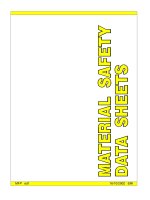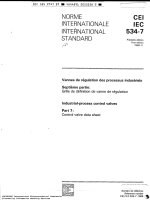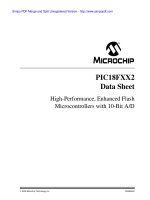MUSRF05 data sheet
Bạn đang xem bản rút gọn của tài liệu. Xem và tải ngay bản đầy đủ của tài liệu tại đây (395.15 KB, 6 trang )
MUSRF05 Interface I.C.
This allows up to 6 of the superb Devantech SRF05 Ultrasonic range-finding modules to
be controlled using a simple serial 2 wire connection from PICAXE or BASIC STAMP.
Features.
Simple serial control from PICAXE or BASIC STAMP.
Simple serial data reading using Serin Command.
Single or multiple sampling.
Individual Control for each Ultrasonic module.
Can return data in inches , centimetres or microseconds.
Can return Minimum and Maximum values when Multi-Sampling.
Uses PIC16F688 controller with calibrated 1% precision timer.
Range up to 5 metres.
Much lower overall cost than multiple I2C modules (SRF08/10).
Saves significant code space in your PICAXE or Stamp.
Saves pins if using multiple sensors.
Overview.
The MUSRF05 controller allows the PICAXE or Stamp programmer to obtain range data from
up to 6 Devantech SRF05 ultrasonic ranger-finder modules.
The command output from PICAXE is of the general syntax:-
Serout <output pin> , T2400 , ( <Command No.> , <No. of Samples> , <Units> )
Reading the returned data is of the general syntax:-
Serin <input pin> , T2400 , <Range> , <Max> , <Min>
See overleaf for more information on data sizes and ‘real world’ formatting.
Our website includes a small PICAXE Basic example showing a simple example.
PICAXE
&
Basic Stamp
Pinout and Connection Detail.
Pin Numbers.
If you look closely at the I.C. case you will see an ‘indent’ at one end.
Pin numbers are referenced to that indent.
1 14
2 13
3 12
4 11
5 10
6 9
7 8
INDENT
Pin
Number
Description Function Notes
1 +ve +5V Power Supply 1
2 Select Format ASCII / Terminal 2
3 US Power O/P Power Switch 3
4 Reset Reset MUSRF05 4
5 SIN Serial in (+2K2 res.) 5
6 SOUT Serial Out (+2K2 res.) 5
7 Indicate LED Indicator 6
8 US6 I/O SRF05 Module 6 7
9 US5 I/O SRF05 Module 5 7
10 US4 I/O SRF05 Module 4 7
11 US3 I/O SRF05 Module 3 7
12 US2 I/O SRF05 Module 2 7
13 US1 I/O SRF05 Module 1 7
14 Gnd 0v Power Ground 1
NOTES. (Please READ them, they are for your information.)
1. The power supply must be a well regulated 5V shared with the Devantech SRF05 Ultrasonic Module(s).
This can also be shared with the PICAXE or Stamp 5V power supply.
We recommend decoupling capacitors (200nF to 10uF) are placed across the +V/Gnd supply pins.
2. Connect this to +V for normal use. If you are want serial output to a PC Terminal type application then connect
this pin to Ground (0V). [ Terminal Format: seconds <space> Av cm <space> Min cm <space> Max cm. ]
In normal use you can send ASCII values to your PC to be read from serial buffer by your own application.
3. This is an inverted output intended to switch a P-Chan MOSFET or PNP transistor.
CAUTION: This is NOT a direct output power supply. Direct connection to a load may cause damage!!
4. Resets the MUSRF05 programme. Can be connected via a push-button switch to Gnd (0V).
Can also be remotely reset by PICAXE / Stamp using the transistor circuit as shown in example.
5. Serial IN is the connection from PICAXE / Stamp output pin. N.B. Connect using 2K2 resistor.
Serial OUT is the return to PICAXE / Stamp input pin. N.B. Connect using 2K2 resistor.
6. LED indicator. Connect via 2K2 for Green LEDs or a 4K7 for Red LEDs.
7. These are the I/O lines to the Devantech SRF05 Ultrasonic modules. (NOT any other types).
These can be connected directly to our SRFMate pcb. Or, if you connect MUSRF05 directly to the SRF05 module,
you must make sure that the SRF05 module ‘Mode’ pin is Grounded.
SRFMate - No U/S Module.
SRFMate with SRF05 Module.
SRFMate makes connection easier and also allows ‘daisy-chaining’ of 5V/Gnd power supply.
MUSRF05
MUSRF05 Command Details and Data Size.
<Value> Units Returned Data Sizes
<Range> <Max> <Min>
<1> Inch Byte Byte Byte
<2> CM Word Word Word
<3> Seconds Word Word Word
PICAXE Examples:
‘ Simplest Command in INCHES.
Serout 7 , T2400 , (1 , 1 , 1) ‘ Tell U/S Module 1 to get a single sample.
Serin 1 , T2400 , b0 ‘ Get result in inches and store in b0
‘ Multi-Sample in Inches
Serout 7 , T2400 , (1 , 5 , 1) ‘ Tell U/S Module 1 to get 5 samples. Return in Inches.
Serin 1 , T2400 , b0 , b1 , b2 ‘ Store Range in b0 , Max val in b1 and Min Val in b2
‘ Simplest Command in Centimetres.
Serout 7 , T2400 , (1 , 1 , 2) ‘ Tell U/S Module 1 to get a single sample.
Serin 1 , T2400 , w0 ‘ Get result in inches and store in b0
‘ Multi-Sample in Centimetres
Serout 7 , T2400 , (1 , 5 , 2) ‘ Tell U/S Module 1 to get 5 samples. Return in Inches.
Serin 1 , T2400 , w0 , w1 , w2 ‘ Store Range in w0 , Max Val in w1 and Min Val in w2
‘ Simplest Command in Microseconds.
Serout 7 , T2400 , (1 , 1 , 3) ‘ Tell U/S Module 1 to get a single sample.
Serin 1 , T2400 , w0 ‘ Get result in inches and store in b0
‘ Multi-Sample in Microseconds
Serout 7 , T2400 , (1 , 5 , 3) ‘ Tell U/S Module 1 to get 5 samples. Return in Inches.
Serin 1 , T2400 , w0 , w1 , w2 ‘ Store Range in w0 , Max Val in w1 and Min Val in w2
Note:
If you choose Multi-Samples the max/min samples are optional, so if you only require an aver-
aged value then omit the second and third parameters. Example:-
‘ Multi-Sample in Inches
Serout 7 , T2400 , (1 , 5 , 1) ‘ Tell U/S Module 1 to get 5 samples. Return in Inches.
Serin 1 , T2400 , b0 ‘ Store Range in b0 . Ignore max and min bytes.
IMPORTANT PICAXE NOTE.
PICAXE is quite slow. In the above examples (shown using w0 , w1 and w2) you may have to replace:
w0 with b0,b1 w1 with b2,b3 w2 with b4,b5
[ e.g. Serin 1 , T2400 , b0 , b1 , b2 , b3 , b4 , b5 ]
Why have Mulitple samples?
Taking an average is the most precise method, by knowing the ‘spread’ of results you can determine the quality of
the measurement. But remember, the more samples you request then the longer the measurement takes.
Results.
The returned values are obviously integer values and therefore have a precision of 1 unit. So, for example, a real
internal measurement of 1.5 inches will be returned as 1 inch and 1.5cm will be returned as 1cm. For greater preci-
sion you may choose to get the results in microseconds and do you own maths. Precision: +/- 1 unit.
Command Details.
Ultrasonic Module Control.
Syntax: Serout <output pin> , T2400 , ( <Command Number> , <No. of Samples> , <Units> )
Command Number: Action
1 to 6 Trigger Ultrasonic Module 1 to 6
10 Switch ON power to U/S Modules
20 Switch OFF power to U/S Modules
No. of Samples
1 to 20 Return averaged range value and Max and Min values
Units
1 Inches
2 Centimetres
3 MicroSeconds
Getting Started.
If you make a circuit which uses the Power Control functions (as in our example overleaf) your first
programme step before getting range data is to Switch ON the power. Note: When you download
a new programme to your PICAXE it will send a bit of nonsense to the output pins.
So to initialise we would recommend you have code a bit like this:-
(Pause 1000 - optional at start if you experience problems)
Serout <o/pin> , T2400 , (255):pause 1000 ‘ Clears MUSRF05 buffer
Serout <o/pin> , T2400 , (10): pause 1000 ‘ Switches U/S power ON
now you can do the code for your range measurements.
General.
It is well worth a look at Devantech’s website at to read up
about the modules and their performance.
It is also a good idea to have a look at the beam patterns of ultra-sonic modules. As you will see
the ‘beam’ pattern is quite a spread and is definitely NOT a pencil beam. Understanding this will
hopefully explain why you sometimes get odd results with ultrasonic range-finding.
Ultrasonic can also bounce around a bit and the longer the range then the more likely you are to
get anomalous results - hence our option for multi-sampling. Multi-sampling won’t cure odd echo
effects but the Min-Max ‘spread’ can be used to get an idea of the level of uncertainty.
TEST CIRCUITS
Evaluation Circuit.
Optional external ‘reset option’ allows remote reset by PICAXE or Stamp.
The ‘serial output option’ inverts the data polarity so it is readbale by your PC
serial buffer. If ‘Select’ is tied to +V the data is ASCII and readable by a user-
designed application. I f ‘Select’ is tied to ground the data is readable in a Termi-
nal type window.
Interface Circuit.
Circuit includes Power Control option.
The ‘select’ pin should be connected
to +5V for normal ASCII use.
MUSRF will only trigger one SRF05
module at any one time, therefore it
is OK to use a low current 5V regula-
tor such as the LPC2950 or similar.
LED flashes to indicate that an
SRF05 module is being triggered.
CONNECTIONS:
US 1 to 6 connect to
SRF05 TRIGGER Input.
Both Serial connections (to & from Basic Stamp / PICAXE) must use 2K2 resistors to limit current.
Further Information.
PICAXE or Basic Stamp Electrical Connections.
1. You must have a commoned ground (0V) between the MUSRF05 ic and your PICAXE / Basic Stamp.
2. Both serial connections (between PICAXE / Basic Stamp and MUSRF05 ic) must use 2K2 resistors.
Ultrasonic Transducer Ranges.
The ranges determined by the SRF05 module depend on the size and material of the target.
We have found that a 175mm square plywood target can be detected accurately up to 2.5m. Beyond that the figures
are not too reliable.
However, a 1m square target was accurately ranged at up to 4 metres. Larger targets were ranged at over 5 metres
The targets used were plywood and positioned along the main axis of the Ultrasonic module.
The Ultrasonic ‘Beam’.
The output from a 40kHz transducer is NOT a ‘pencil’ beam. This
diagram shows a typical output spread.
You should realise that the physical positioning of the transducer /
module is very important.
After all, if you position it too close to the ground then you will get the
reflection from the ground rather than the intended target.
This becomes more important as the target distance increases.
Full Spec: />It is possible to make short tubes and lined with a soft material to ad-
just the pattern. You may choose to experiment, but remember, you
will probably affect the maximum range. Do NOT use metal.
Beam Spread @ 40kHz (-6dB)
MUSRF05 Electrical Specifications (Typical).
Power 5V DC (Variations from this may affect oscillator frequency and accuracy)
I (Supply) 1mA average (IC only. Each SRF05 takes about 4mA on average)
Boot Up Time About 500mS after power-on / reset.
Sample Delay Depends on range. You must include a 50mS Pause between trigger requests.
Osc. Accuracy 1% Factory Calibrated (Microchip spec)
Range Accuracy + / - 1 inch or +/- 10 microseconds.
Serial Polarity IN PICAXE T2400 . All others 2400 baud Inverted.
Serial Polarity OUT As above.
Serial Line load Both serial connections must use a 2K2 resistor in-line to limit current.
P.O. Box 2509 Wareham Dorset BH20 6YH U.K.
Tel: +44 (0)1929 405388 Fax: 448719941420
E-Mail:









